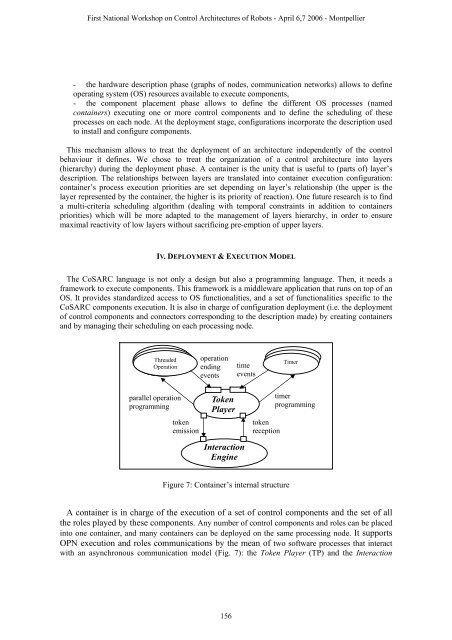Pleading for open modular architectures - Lirmm
Pleading for open modular architectures - Lirmm
Pleading for open modular architectures - Lirmm
You also want an ePaper? Increase the reach of your titles
YUMPU automatically turns print PDFs into web optimized ePapers that Google loves.
First National Workshop on Control Architectures of Robots - April 6,7 2006 - Montpellier<br />
- the hardware description phase (graphs of nodes, communication networks) allows to define<br />
operating system (OS) resources available to execute components,<br />
- the component placement phase allows to define the different OS processes (named<br />
containers) executing one or more control components and to define the scheduling of these<br />
processes on each node. At the deployment stage, configurations incorporate the description used<br />
to install and configure components.<br />
This mechanism allows to treat the deployment of an architecture independently of the control<br />
behaviour it defines. We chose to treat the organization of a control architecture into layers<br />
(hierarchy) during the deployment phase. A container is the unity that is useful to (parts of) layer’s<br />
description. The relationships between layers are translated into container execution configuration:<br />
container’s process execution priorities are set depending on layer’s relationship (the upper is the<br />
layer represented by the container, the higher is its priority of reaction). One future research is to find<br />
a multi-criteria scheduling algorithm (dealing with temporal constraints in addition to containers<br />
priorities) which will be more adapted to the management of layers hierarchy, in order to ensure<br />
maximal reactivity of low layers without sacrificing pre-emption of upper layers.<br />
IV. DEPLOYMENT & EXECUTION MODEL<br />
The CoSARC language is not only a design but also a programming language. Then, it needs a<br />
framework to execute components. This framework is a middleware application that runs on top of an<br />
OS. It provides standardized access to OS functionalities, and a set of functionalities specific to the<br />
CoSARC components execution. It is also in charge of configuration deployment (i.e. the deployment<br />
of control components and connectors corresponding to the description made) by creating containers<br />
and by managing their scheduling on each processing node.<br />
Threaded Threaded<br />
Operation<br />
Threaded<br />
Operation Operation<br />
parallel operation<br />
programming<br />
token<br />
emission<br />
operation<br />
ending<br />
events<br />
Token<br />
Player<br />
Interaction<br />
Engine<br />
time<br />
events<br />
token<br />
reception<br />
Figure 7: Container’s internal structure<br />
Timer<br />
Timer<br />
Timer<br />
timer<br />
programming<br />
A container is in charge of the execution of a set of control components and the set of all<br />
the roles played by these components. Any number of control components and roles can be placed<br />
into one container, and many containers can be deployed on the same processing node. It supports<br />
OPN execution and roles communications by the mean of two software processes that interact<br />
with an asynchronous communication model (Fig. 7): the Token Player (TP) and the Interaction<br />
156

















